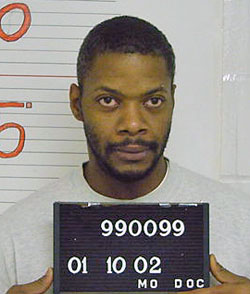Marlin Gray (Marlin A. Gray)

On the night of April 4/morning of April 5, 20-year-old Julie Kerry, 19-year-old Robin Kerry, and their 19-year-old cousin, Thomas Cummins, were on the Chain of Rocks Bridge over the Mississippi River. Gray, Antonio Richardson, Reginald Clemons, and Daniel Winfrey went to the bridge that night together. The two groups, who did not know each other, had a brief conversation. Gray showed the other group how to climb down a manhole cover on the bridge down to the pier. Then the two groups separated. According to testimony offered on behalf of the prosecution, several minutes later the group of four men decided to rob the three, with Winfrey testifying that Gray said he “felt like hurting somebody.” They returned and Gray told Cummins that “This is a robbery. Get down on the ground.” The two girls were grabbed and held on the ground. Richardson held Julie down while Clemons raped her and then the two swapped positions. Gray, Richardson, and Clemons then alternately raped Robin and Julie. Cummins was then robbed of his wallet, wristwatch, cash, and keys, and the three victims were forced down the manhole cover to the concrete pier. The two Kerry sisters then were pushed, and Cummins jumped as instructed. Medical witnesses testified that Cummins and Julie Kerry survived the 48-foot (15 m) fall to the water below. Cummins testified that after surfacing, the current pulled him over to Julie, but then she drifted off after he began to drown. Cummins swam to shore and survived. The body of Julie Kerry was found three weeks later near Caruthersville, Missouri; the body of Robin Kerry was not found.
Gray’s version of the events was very different. In an interview in 2005, he said that after parting from the group of three, Gray went to a car where he smoked marijuana, while Richardson went to retrieve a flashlight (stolen by Richardson from a police officer’s residence) he had left on the bridge. Gray returned to the bridge 30 minutes later to find that the girls and their cousin were gone. Richardson said that Cummins had said the girls had slipped off the bridge but thought the authorities would not believe this story. Cummins was then robbed by the men of his belongings. The version given by Gray at his trial was different, and also differs from what police said that he told them in his initial interview. On returning after 30 minutes in the car, Clemons informed him that “Man, I just robbed that guy and threw him and the girls into the river.” Gray’s mother testified that he was at home all night and never left their residence. Police initially refused to believe Thomas Cummins’ version of the events. They theorized that the other men never existed and he had made up the story to cover up his attempted rape of his cousins. They believed Julie had fallen off the bridge while resisting his sexual advances, Robin had jumped in to save her, and both had drowned. Thomas was initially charged with murder but released due to lack of evidence. He later won a settlement from the St.Louis police department for wrongful interrogation techniques.
Daniel Winfrey, who was 15 years old at the time, confessed to the murder in the presence of police and his parents. He pleaded guilty to second-degree murder and forcible rape and testified against the other three in their trials. He received a 30-year sentence. He testified that Clemons and Richardson were the ones who had pushed the two girls. Winfrey was the only white member of the convicted group, which has been raised as a criticism since he was the main prosecution witness. Winfrey was granted parole in the summer of 2007; when released, he had served 15 years. Clemons was sentenced to death and still is on death row. Richardson was also given a death sentence, however, it was commuted to life in prison by the Supreme Court of Missouri on October 28, 2003. The court cited his sentencing by a judge rather than a jury to be in violation of Apprendi v. New Jersey (a case that was decided long after the imposition of sentence). Richardson had been the focus of strenuous efforts by death penalty opponents due to his alleged mental deficiencies and because of his youth at the time of the murders, even though his own psychologist and his mother testified that he “know[s] the difference between right and wrong.” In 2005, the Supreme Court of the United States ruled that executions of persons who committed their crimes as juveniles were unconstitutional.
Gray’s execution date was set by the Missouri Supreme Court for September 26, 2005. Governor Matt Blunt denied Gray clemency on October 25 based on a recommendation by the Missouri Board of Probation and Parole. That same day, the Supreme Court of the United States denied his motions to stay his execution. Gray asked that no member of his family witness the execution, which he described as “murder,” although a female cousin and a minister were present. The only witness for the victims present at the execution was Kevin Cummins, the uncle of the two girls. Gray also made no last meal request and gave no instructions for the disposal of his body. His final statement: “I go forward now on wings built by the love and support of my family and friends. I go with a peace of mind that comes from never having taken a human life. I forgive those who have hardened their hearts to the truth and I pray they ask forgiveness, for they know not what they do. This is not a death, it is a lynching.”
Born
- September, 29, 1967
- USA
Died
- October, 26, 2005
- USA
- Bonne Terre, Missouri
Cause of Death
- execution by lethal injection

